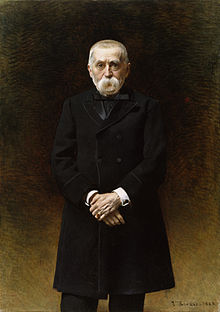William Thompson Walters
| William Thompson Walters | |
|---|---|

William T. Walters in 1883 by french artist Léon Bonnat.
|
|
| Born |
Henry Walters May 23, 1820 Liverpool, Pennsylvania |
| Died | November 22, 1894 Baltimore, Maryland, U.S. |
| Resting place | Green Mount Cemetery, Baltimore |
| Residence | Baltimore, Maryland, U.S. |
| Nationality | American |
| Known for | Art Collector |
| Spouse(s) | Ellen Harper Walters (1822–1862) |
| Children | Henry Walters (1848–1931) Jennie Walters Delano (1853–1922) |
William Thompson Walters (May 23, 1820 – November 22, 1894) was an American businessman and art collector, whose collection formed the basis of the Walters Art Museum.
He was born in Liverpool, Pennsylvania in 1820. He was educated as a civil engineer, but became interested in the coal and iron industry. While directing a smelting establishment in Pennsylvania, Walters produced the first iron manufactured from mineral coal in the United States.
He moved to Baltimore in 1841, where he worked as a grain merchant and in 1847 became established as a liquor wholesaler.
He spent much of the American Civil War in Europe, where he studied and purchased art. After the end of the war, he returned to the United States, where he invested in banking and railroads, founding the Atlantic Coast Line. He was appointed as the United States commissioner at the Paris expositions of 1867 and 1878, and also to that at Vienna in 1873. In the late 1880s he took in business in the horse trade, importing Percheron horses with his partner Samuel Hopkins.
Gravestone detail
In 1846, Walters married Ellen Harper (1822–62), daughter of a prosperous Philadelphia merchant and his wife. They had a son Henry (b. 1848) and daughter Jennie Walters. Ellen died young of pneumonia, contracted when they were traveling in England.
With his success in business secured, Walters turned to art collection, purchasing contemporary American and European works. During the American Civil War, he took his wife to Europe and lived in Paris. (Their children were in boarding school in the US part of the time.) They traveled widely in Europe, where Walters cultivated his interest in art, and purchased numerous additions for his collection.
In addition to contemporary European work, Walters began to collect Asian art and ceramics. His private collection became one of the largest and most valuable in the United States.
From 1874 onwards, Walters opened his house in Mount Vernon Place to the public most springs, with a 50 cent entrance fee; all proceeds went to charity. This annual exhibit of his gallery netted $30,000 for the poor of Baltimore.
...
Wikipedia
